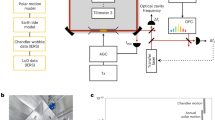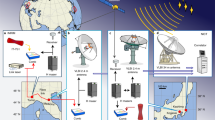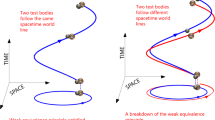Abstract
New techniques are being developed to improve the spatial and temporal resolutions achievable in measurements of the rotation vector of the Earth. Such improvements are expected to expose fine details of this rotation and to aid in understanding their physical causes. Although not yet fully developed, two of these techniques are now in routine use: radio interferometry and laser ranging. In the former technique, antennas up to thousands of kilometres apart are used to observe compact extragalactic radio sources. The differences in arrival time of the signals propagating from each source to the antennas, measured by the method of very-long-baseline interferometry (VLBI), are sensitive to variations in each of the components of the Earth's rotation vector. In the latter technique, lasers are used to measure the distance (range) to artificial Earth satellites (satellite laser ranging, SLR) and to optical retroreflectors on the Moon (lunar laser ranging, LLR). To assess the accuracy being achieved in the measurement of Earth rotation it is useful to compare results obtained with these different techniques. National programmes and international cooperation, exemplified by the International Astronomical Union/International Union of Geodesy and Geophysics project MERIT1,2, are encouraging the collection of data suitable for accurate intercomparisons. Here we compare results for a 400-day period from late September 1980 to December 1981, for which data from all three types of measurements are available. We also compare corresponding results from classical astrometric observations which demonstrate the degree of improvement in accuracy afforded by the new techniques.
This is a preview of subscription content, access via your institution
Access options
Subscribe to this journal
Receive 51 print issues and online access
$199.00 per year
only $3.90 per issue
Buy this article
- Purchase on Springer Link
- Instant access to full article PDF
Prices may be subject to local taxes which are calculated during checkout
Similar content being viewed by others
References
Wilkins, G. A. & Feissel, M. (eds) Project MERIT: Report on the Short Campaign and Grasse Workshop with Observations and Results on Earth-Rotation During 1980 August–October (Royal Greenwich Observatory, Herstmonceux, 1982).
Wilkins, G. A. (ed.) Project MERIT: A Review of the Techniques to be Used During Project MERIT to Monitor the Rotation of the Earth (Royal Greenwich Observatory, Herstmonceux, 1980).
Robertson, D. S. & Carter, W. E. in High Precision Earth Rotation and Earth–Moon Dynamics (ed. Calame, O.) 97–122 (Reidel, Dordrecht, 1982).
Tapley, B. D., Schutz, B. E. & Eanes, R. J. Proc. 4th IAG Laser Ranging Workshop, 523–567 (University of Texas, Austin, 1981).
Schutz, B. E., Tapley, B. D. & Eanes, R. J. in A. Rep. 1980 D27–D36 (Bureau International de l'Heure, Paris, 1981).
Langley, R. B., King, R. W., & Shapiro, I. I. J. geophys. Res. 86, 11913–11918 (1981).
Langley, R. B., King, R. W., Morgan, P. J. & Shapiro, I. I. in High Precision Earth Rotation and Earth–Moon Dynamics (ed. Calame, O.) 25–30 (Reidel, Dordrecht, 1982).
Feissel, M. in A. Rep. 1980, 1981 (Bureau International de l'Heure, Paris, 1981, 1982).
A. Rep. 1981 (Bureau International de l'Heure, Paris, 1982).
Author information
Authors and Affiliations
Rights and permissions
About this article
Cite this article
Robertson, D., Carter, W., Eanes, R. et al. Comparison of Earth rotation as inferred from radio interferometric, laser ranging and astrometric observations. Nature 302, 509–511 (1983). https://doi.org/10.1038/302509a0
Received:
Accepted:
Published:
Issue Date:
DOI: https://doi.org/10.1038/302509a0
This article is cited by
Comments
By submitting a comment you agree to abide by our Terms and Community Guidelines. If you find something abusive or that does not comply with our terms or guidelines please flag it as inappropriate.



